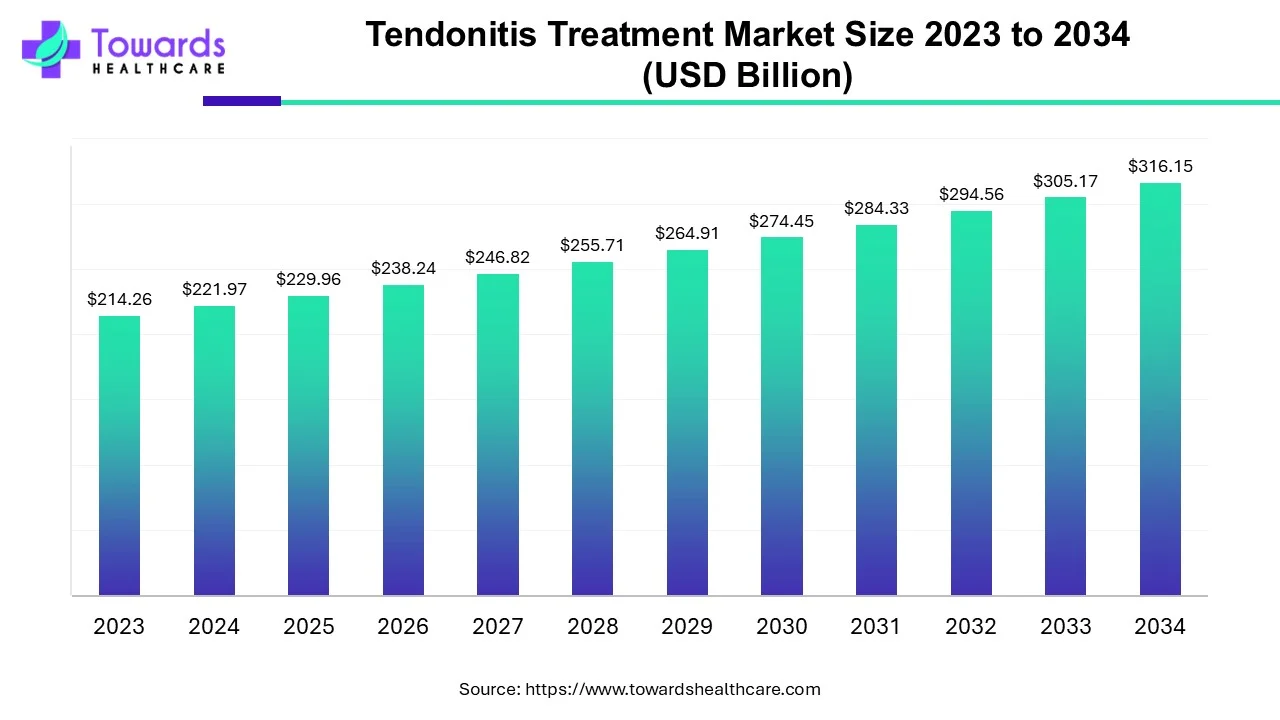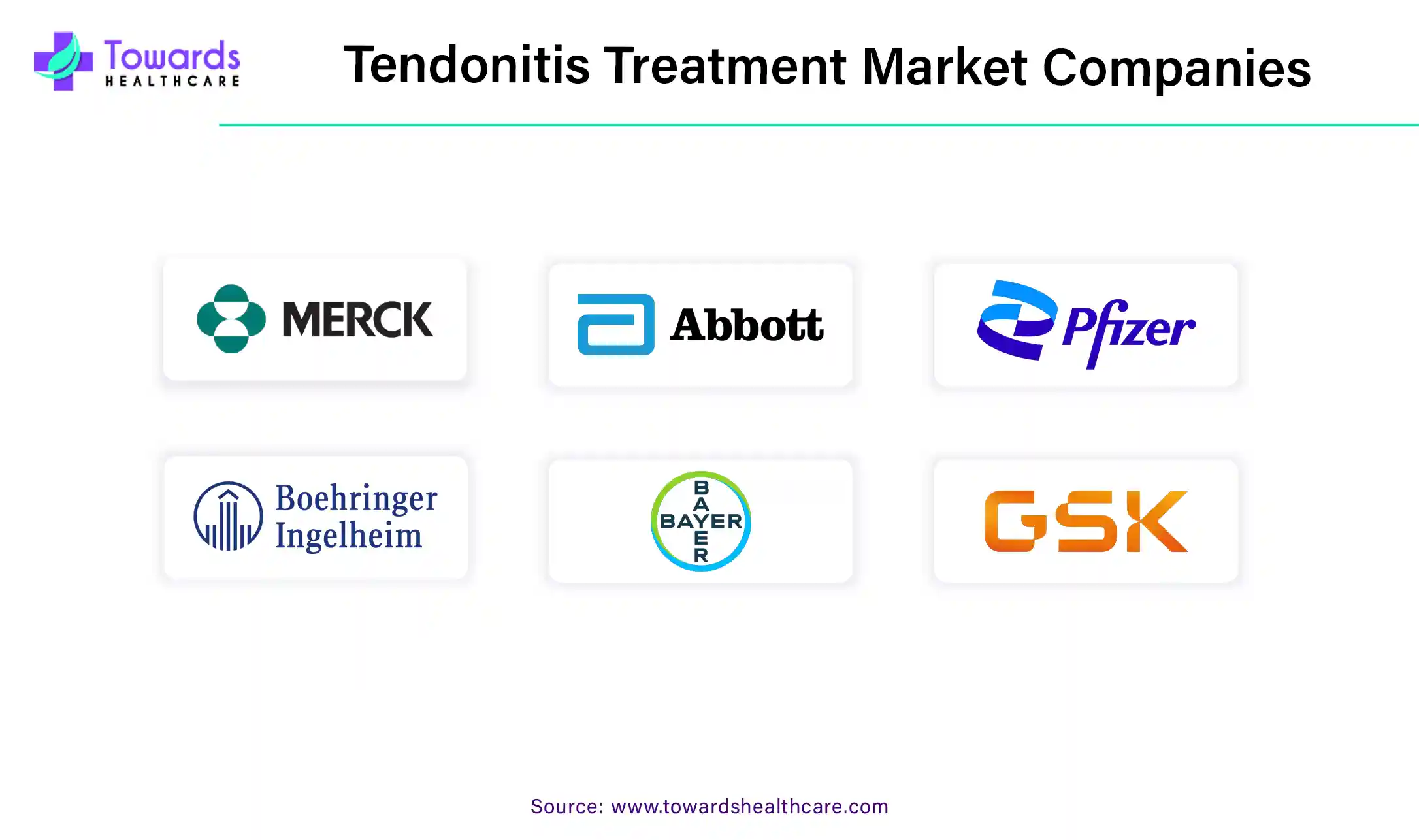December 2025

The tendonitis treatment market size is projected to reach USD 316.15 billion by 2034, growing from USD 229.96 billion in 2025, at a CAGR of 3.6% during the forecast period from 2025 to 2034.

Every year, over 70,000 Americans can't go to work because of tendonitis, as shown by the Bureau of Labor Statistics. This number keeps going up, emphasizing the need for better treatment options.
Tendonitis occurs when tendons, connecting muscle to bones, become inflamed. Imagined our body, as well as a coordinated team -muscles and tendons, are working seamlessly. In tendonitis, some team members (tendons) strain, causing pain. The affected areas frequently include the shoulders, elbows, wrists, knees and heels.
Here are some common names for different types of tendonitis:

The rising occurrence of tendonitis among the general public, with approximately 5 to 10 cases per 100,000 individuals, is expected to drive market demand in the forecast period. Various The availability of diverse treatment choices including over-the-counter medications, surgical interventions, and physical therapy has led to a higher number of people seeking treatment, thus stimulating industry growth. Physical therapy, known for its eccentric strengthening techniques, stands out as a primary treatment option for individuals with chronic tendon issues, proving to be effective in managing such conditions.
Overworked tendons lead to pain, swelling, and tenderness in the affected area. Activities involving the affected tendons may exacerbate the discomfort. Common types of tendonitis include tennis elbow, golfer elbow, and Achilles tendonitis. Risk factors for developing tendonitis include age, as tendons become less flexible with time, and engaging in activities that involve repetitive motion. Treatment often involves rest, ice, compression and elevation (RICE), along with anti-inflammatory medications. Physical therapy, exercise, and lifestyle modification are also recommended.
If left untreated, chronic tendonitis may lead to long-term pain and reduced mobility. Prevention strategies include proper warm-up before activities, using ergonomic equipment, and incorporating regular breaks during repetitive tasks. Seeking medical advice is crucial for an accurate diagnosis and personalized treatment plan.
Physical therapy is useful in treating tendinopathies of the upper and lower limbs, according to the International Journal of Physiotherapy. This helps to explain the expected increase in market demand. Tendons are highly elastic connective tissues that transfer force from muscles to bones, but they can get injured easily. Athletes and sports players report over 32 million tendon-related injuries each year; tendinopathies account for half of these injuries. During the forecast period, factors like treatment-related side effects, extended periods of inactivity, and unexpected injuries are anticipated to drive industry growth.
As more people engage in sports activities, like likelihood of tendonitis rises. The erosion on tendons during physical exertion can lead to inflammation and injury. This is particularly true in high impact sports or those requiring repetitive motions. The growing popularity of sports, as it translate to an increased pool of potential patients.
Additionally, the ageing population contribute to the surge in tendonitis cases. Aging tends to weaken tendons, making them more susceptible to the injury. With an increasing numbers of seniors participating in the sports or fitness activities, the demand for tendonitis. Advancement in the medical treatments, including innovative therapies and rehabilitation methods. Improved understanding of the condition, coupled with more effective interventions, encourages individuals to seek medical attention. As awareness spreads and diagnostic capabilities enhance, the diagnostic rates for tendonitis increase.
Occupational exposure to repetitive movement and physical strain significantly elevates the risk of tendonitis. Jobs that involve repeated motions, such as typing assembling in the line work, or manual labor, can place continuous stress on specific tendons. This prolonged strain may lead to inflammation and injury, ultimately contributing to the demand for tendonitis treatment.
Worker in occupations like construction, manufacturing, and data entry often engage in repetitive tasks, causing the depletion of their tendons. Over time, this depletion can result in conditions like tendonitis, prompting affected individuals to seek medical assistance. The amplification of the tendonitis treatment market within these occupational settings is fueled by the sheer number of individuals exposed to these risk factors. As workers discomfort or pain due to occupational strain, the demand for treatments, ranging from conservative measures like rest and physical therapy to more advanced interventions, rises.
Regular breaks are crucial because they give the body time to recover. Taking short pauses during work to stretch or change positions can prevent the overuse of specific muscles and reduce strain on tendons. Stretching exercises, especially those targeting areas prone to tendonitis, can be beneficial. Additionally, strengthening exercises can help build muscle support around the tendons, providing them with better protection. Workers should be educated about the importance of proper techniques and movement to avoid unnecessary strain.
Employers play a vital role in promoting a healthy work environment. They can provide ergonomic tools and equipment, conduct training on proper workplace practices, and encourage a culture that prioritizes employee well-being. If tendonitis symptoms arise, early intervention is crucial. Ignoring pain or discomfort may lead to more severe issues. Seeking medical advice, using ice or heat therapy, and if necessary, modifying work tasks can contribute to a faster recovery.
Corticosteroid injections are commonly used to treat tendonitis, which happens when tendons get inflamed due to overuse or injury. These injections deliver strong anti-inflammatory medicine right into the sore area to help reduce pain and swelling. The corticosteroid, which is like a synthetic version of the body's natural cortisol, works by calming down the immune response that causes the inflammation. This helps ease pain and lets the tendon heal.
Although corticosteroid injections can give a lot of relief, they're usually seen as a short-term fix. Using them too much can weaken the tendon and might make it more likely to get hurt again. It's also important to know that not everyone can use corticosteroid injections. They can cause side effects like temporary pain where the injection goes in, making the skin thinner, or even causing the tendon to tear if they're used too often.
Before deciding on corticosteroid injections, it's really important to talk to a healthcare professional about the good and bad things about this treatment. They can help figure out if it's the right choice for your particular problem and come up with a plan to manage your tendonitis.
Accurately diagnosing and distinguishing between various tendon disorders poses a significant challenge in healthcare. Tendons are tough connectors between bones and muscles, and when they become inflamed or injured, it can lead to tendonitis. The symptoms of tendon disorders often overlap with those of other conditions, making it difficult to pinpoint the exact problem.
Many tendon disorders show similar signs such as pain, swelling, and limited movement, making it tricky to differentiate them based solely on these symptoms. Standard imaging techniques like X-rays or MRIs may not always provide a clear picture of tendon conditions, whether they're chronic or acute injuries, which require different approaches to diagnosis and treatment. Specialized knowledge is needed to identify these disorders accurately, but not all healthcare providers may have extensive experience in this area, potentially leading to misdiagnosis. There are gaps in research understanding tendon biology and pathology, which hinders the development of precise diagnostic tools and methods.
The overlapping symptoms and limitations of certain diagnostic tools contribute to the challenges in accurately diagnosing tendonitis. It often requires a thorough evaluation by healthcare professionals to rule out other possibilities and confirm the condition.
The tendonitis treatment market in North America is widespread, impacting various regions, including major urban areas like New York, Los Angeles, and Toronto, which host numerous healthcare facilities specializing in tendonitis treatment. Additionally, suburban and rural areas contribute to the market, with a variety of clinics and hospitals offering treatment options. The increasing number of tendonitis surgeries in the region has become a significant driver for growth, indicating a rising demand for tendonitis treatment in North America. This surge is closely linked to the affordability of such medical procedures. The emergence of local manufacturers and renowned players not only fosters innovation but also enhances the accessibility of medical solutions. This synergy can lead to the development of more personalized and cost-effective treatment options. The rise of local medical device makers and partnerships with major players offer significant opportunities for industry growth. Key players' research to broaden product reach is also accelerating market growth in the region.

In the Asia-Pacific region, the landscape for tendonitis treatment varies across different countries and areas. Even in smaller towns and rural areas, there are facilities providing options for tendonitis care. The market for tendonitis treatment in Asia-Pacific is growing due to an increase in the number of people getting diagnosed and treated for tendonitis. This growth is driven by factors like better access to healthcare and increasing awareness about tendonitis. Local companies and big players in the medical industry are working together to come up with new and better treatments for tendonitis. This collaboration makes treatments more accessible and can lead to innovations that make them more effective and affordable. The tendonitis treatment landscape in the Asia-Pacific region is evolving, with more options becoming available to people in different parts of the region.
The competitive landscape for the tendonitis treatment market is like a big playground with different companies trying to be the best at treating tendon problems. Imagine several teams playing a game, each trying to win by offering the best solutions for tendonitis. There are big players, like well-known medical companies, and smaller ones, like local businesses, all competing to come up with the most effective treatments for tendonitis. They might create medicines, devices, or therapies to help people with tendon problems feel better. These companies often try to outdo each other by researching and developing new products or improving existing ones. They might also try to offer their products at better prices or make them more accessible to people who need them.

By Type
By Treatment
By Geography
December 2025
December 2025
December 2025
November 2025